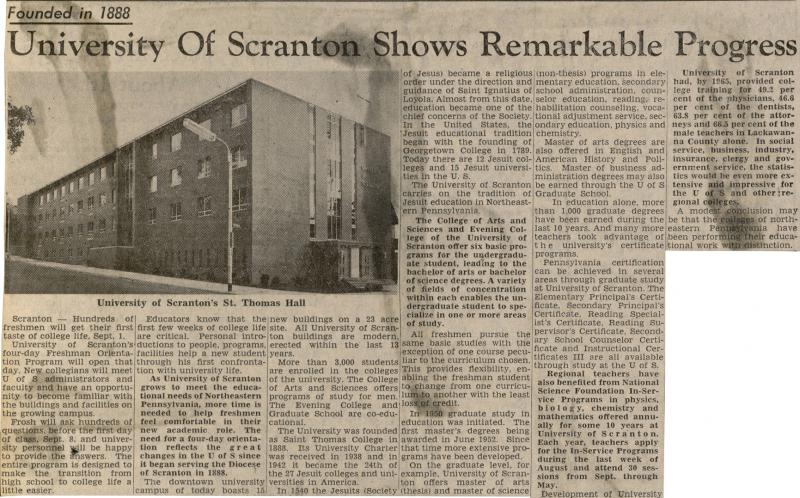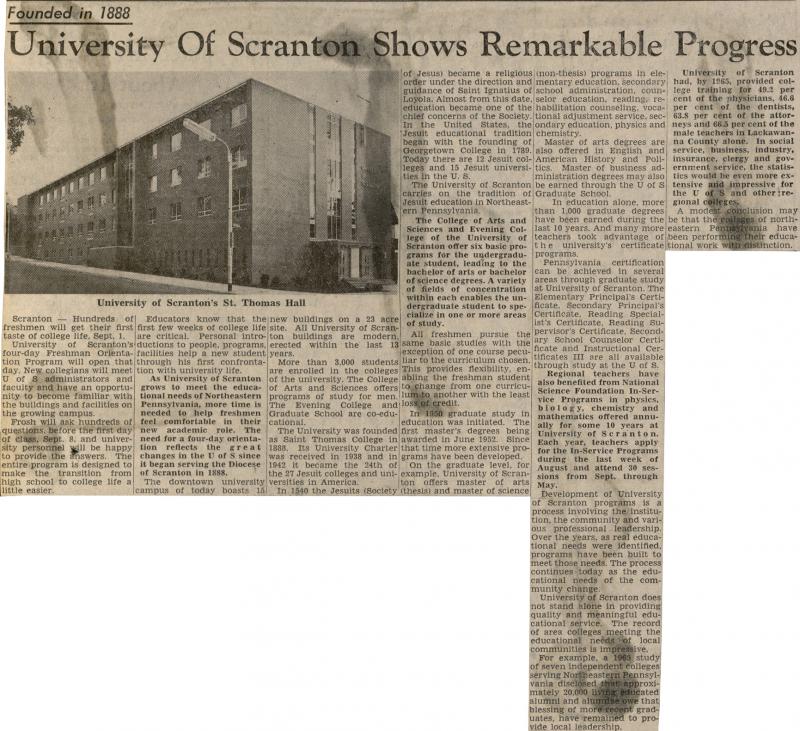Founded in 1888: University of Scranton Shows Remarkable Progress, 1970
Item
- Title
- Description
- Date
- Subject
- Source
- Record Identifier
- Exhibit Section
- Copyright
- Transcript
-
Founded in 1888: University of Scranton Shows Remarkable Progress, 1970
-
Catholic Light article about progress at the University of Scranton over the years.
-
1970-08-13
-
University of Scranton Archives
-
univscrapbook-b020_0136b
-
Times Shamrock Communications
-
[Please note that computer-generated transcripts include formatting, spelling, and grammatical irregularities and errors.]
Founded in 1888
University Of Scranton Shows Remarkable Progress
University of Scranton's St. Thomas Hall
Scranton — Hundreds of freshmen will get their first taste of college life, Sept. 1. University of Scranton's four-day Freshman Orientation Program will open that day. New collegians will meet U of S administrators and faculty and have an opportunity to become familiar with the buildings and facilities on the growing campus. Frosh will ask hundreds of questions, before the first day of class, Sept. 8. and university personnel will be happy to provide the answers. The entire program is designed to make the transition from high school to college life a little easier. Educators know that the first few weeks of college life are critical. Personal introductions to people, programs, facilities help a new student through his first confrontation with university life. As University of Scranton grows to meet the educational needs of Northeastern Pennsylvania, more time is needed to help freshmen feel comfortable in their new academic role. The need for a four-day orientation reflects the great changes in the U of S since it began serving the Diocese of Scranton in 1888. The downtown university campus of today boasts 15 new buildings on a 23 acre site. All University of Scranton buildings are modern, erected within the last 13 years. More than 3,000 students are enrolled in the colleges of the university. The College of Arts and Sciences offers programs of study for men. The Evening College and Graduate School are co-educational. The University was founded as Saint Thomas College in 1888. Its University Charter was received in 1938 and in 1942 it became the 24th of the 27 Jesuit colleges and universities in America. In 1540 the Jesuits (Society of Jesus) became a religious order under the direction of Saint Ignatius of Loyola. Almost from this date, education became one of the chief concerns of the Society. In the United States, the Jesuit educational tradition began with the founding of Georgetown College in 1789. Today there are 12 Jesuit colleges and 15 Jesuit universities in the U.S. The University of Scranton carries on the tradition of Jesuit education in Northeastern Pennsylvania. The College of Arts and Sciences and Evening College of the University of Scranton offer six basic programs for the undergraduate student, leading to the bachelor of arts or bachelor of science degrees. A variety of fields of concentration within each enables the undergraduate student to specialize in one or more areas of study. All freshmen pursue the same basic studies with the exception of one course peculiar to the curriculum chosen. This provides flexibility, enabling the freshman student to change from one curriculum to another with the least loss of credit. In 1950 graduate study in education was initiated. The first master's degrees being awarded in June 1952. Since that time more extensive programs have been developed. On the graduate level, for example, University of Scranton offers master of arts (thesis) and master of science (non-thesis) programs in elementary education, secondary school administration, counselor education, reading, rehabilitation counseling, vocational adjustment service, secondary education, physics and chemistry. Master of arts degrees are also offered in English and American History and Politics. Master of business administration degrees may also be earned through the U of S Graduate School. In education alone, more than 1.000 graduate degrees have been earned during the last 10 years. And many more teachers took advantage of the university's certificate programs. Pennsylvania certification can be achieved in several areas through graduate study at University of Scranton. The Elementary Principal's Certificate. Secondary Principal's Certificate. Reading Specialist's Certificate. Reading Supervisor's Certificate. Secondary School Counselor Certificate and Instructional Certificates III are all available through study at the U of S. Regional teachers have also benefited from National Science Foundation In-Service Programs in physics, biology, chemistry and mathematics offered annually for some 10 years at University of Scranton. Each year, teachers apply for the In-Service Programs during the last week of August and attend 30 sessions from Sept. through May. Development of University of Scranton programs is a process involving the-institution, the community and various professional leadership. Over the years, as real educational needs were identified, programs have been built to meet those needs. The process continues today as the educational needs of the community change. University of Scranton does not stand alone in providing quality and meaningful educational service. The record of area colleges meeting the educational communities is impressive. For example, a 1965 study of seven independent colleges serving Northeastern Pennsylvania disclosed that approximately 20,000 living educated alumni and alumnae owe that blessing of more recent graduates, have remained to provide local leadership. University of Scranton had, by 1965, provided college training for 49.2 per cent of the physicians, 46.6 per cent of the dentists, 63.8 per cent of the attorneys and 66.5 per cent of the male teachers in Lackawanna County alone. In social service, business, industry, insurance, clergy and government service, the statistics would be even more extensive and impressive for the U of S and other regional colleges. A modest conclusion may be that the colleges of northeastern Pennsylvania have been performing their educational work with distinction.
- Item sets

